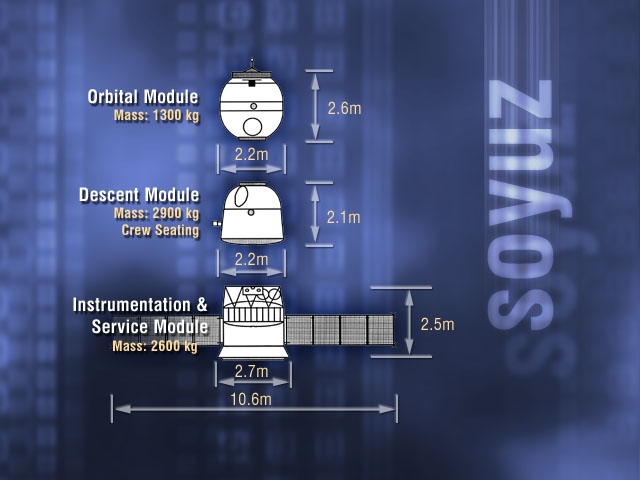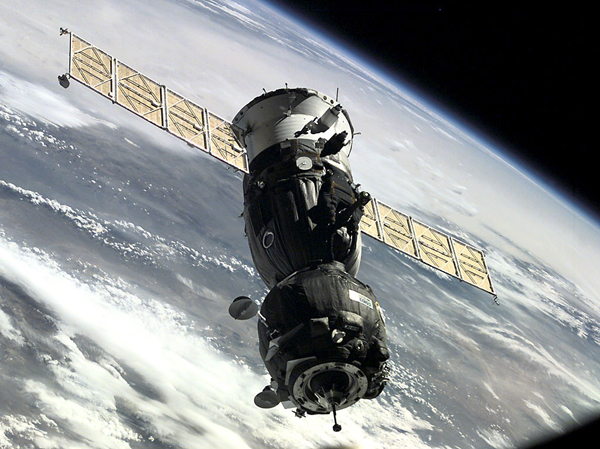
Space program Soyuz
Soyuz Space Program
The Soyuz program (Russian for “Union”) has a long history and several phases of development.
The first phase (1962-1965) - initial development of the spacecraft as part of circumlunar flights program. In 1962, in the OKB-1 under the direction of Korolev S.P. a rocket and space complex started, which consisted of three vehicles: 7K, 9K and 11K. This project was named as Soyuz and was carried out in order to perform manned circumlunar missions. Spacecraft 7K was developed to ascent cosmonauts to the Earth’s orbit, dock with 9K spacecraft, perform the mated manned flight round the Moon and return cosmonauts to Earth in the descent module of 7K vehicle. Spacecraft 9K was used as a booster rocket with the propulsion system, which would provide the insertion of 7K-9K complex into circumlunar trajectory. 11K was an oil-carrying spaceship, which was supposed to refill 9K spaceship after docking to it, and once the refilling was complete, undock from 9K vehicle. All vehicles were to be launched using Soyuz launch vehicle in the following order: first - 9K vehicle without fuel, then - four 11K oil-carrying spaceships launched in series, and only after that 7K vehicle with a crew onboard. Six launch vehicles would be used to assemble 7K-9K orbital complex.
In 1965, as new lunar program – L-1 (Ë-1) was approved, the Soyuz project (at this time, the Soyuz project was still under design) was reassigned to developing a manned orbital spacecraft, designated as 7K-OK and inherited the title of the project. The development of 9K and 11K space vehicles was terminated.

The second phase (1965-1970) - the creation and operation of the Soyuz orbital vehicle. The Soyuz 7K-OK spacecraft was also called as 11Ô615 and was intended for manned autonomous orbital flights, maneuver operations and docking at earth’s orbit, as well as to implement some experiments.
The 7K-OK spacecrafts were of two types: 7K-OK (A) with an active docking node with a probe, and 7K-OK (P) with a passive docking node with a cone. Docking nodes did not have an internal transfer hatch. The cosmonauts could transfer from one spacecraft to another via open space wearing Yastreb (Russian for “Hawk”) spacesuits equipped with life support system in the backpack. Inhabited modules of the spacecrafts were used as airlock chambers. The cosmonauts performed spaceflights without rescue spacesuits (wearing flight suits only).
The first unmanned test flight of the 7K-OK was implemented November 28-30, 1966 (Cosmos-133). The first manned launch of the spacecraft took place on April 23, 1967 (Soyuz-1). Totally 16 Soyuz spacecrafts of 7K OK modification were launched - 8 manned and 8 unmanned ones. The main results of this phase were: maneuvering operations, search phase, automatic and manned modes of rendezvous and docking of spacecrafts on the Earth orbit were implemented. In addition, some experiments were carried out. Soyuz-9 spacecraft performed a long-term space flight (over 17 days).
The third phase (1969-1981) - the creation and operation of the Soyuz spacecraft. The transport modification of the Soyuz - 7K-T was designed to deliver crews to a long-term Salyut orbital station and Almaz manned orbital station in 1969-1970. The 7K-T space vehicle had the following designations: 11Ô615A8 - for the long-term space station, 11Ô615A9 - for the manned orbital station. The 7K-T modification had only an active docking assembly with a transfer hatch, allowed the cosmonauts to pass onboard the orbital station. In connection with the death of the Soyuz-11spacecraft crew due of depressurization of the descent module, it was agreed to use Sokol-K rescue space suits for the cosmonauts. After the spacecraft update (in 1971-1972), the transport vehicle crew was reduced to two cosmonauts due to the weight limitation (before the crews consisted of three cosmonauts, performed spaceflights without space suits).
In addition a new modification 7K-TM (11Ô615A12 or 11Ô615M) based on 7K-T spacecraft was created for the ÀPAS Soviet-American program in 1972. 7K-TM spacecraft had an androgynous docking assembly with a manhole hatch. Androgynous docking assembly could be used both in active and passive modes. There were 38 launches of Soyuz vehicles of 7K-T and 7K-TM modifications: - 31 manned (one performed a suborbital flight because of the rocket booster failure in 1975) and 7 unmanned.
The main results of this phase: the spacecrafts provided the delivery of the Soviet and international crews (the Intercosmos program) to the orbital stations Salyut-1, -3, -4, -5, -6, and their return to the Earth, docking of the Soyuz-19 with an American spacecraft Apollo (APAS program) was carried out.
The fourth phase (1967-1977) - the creation of the 7K-C space vehicle. In November 1967, in ÖÊÁÝÌ (Central Design Bureau of Experimental Engineering, formerly EDB-1) under the leadership of Chief Designer V.P. Mishin started designing of Soyuz - 7K-C modification, which also received the designation of 11Ô732. It was designed as a transport vehicle that had to be docked to the orbital spacecraft OK-VI (OK-ÂÈ), and to deliver two cosmonauts for implementation of military experiments. It was planned to install an experimental military small-weapon and missile munitions on the habitable compartment of the 7K-C vehicle. In autonomous flight of the 7K-C spacecraft it was planned to implement refinement and testing of space-to-space missiles. The 7K-C space vehicle had the opportunity of rapid separation of habitable compartment on the Earth's orbit if a problem occurred in armament systems. ÖÊÁÝÌ completed creation of the 7K-C modification In 1974. Three spacecrafts were made and flight-design tests (LCI) of the unmanned spacecraft (Cosmos-670, Cosmos-772 and Cosmos-869) were carried out in the years 1974-1976.
The fifth phase (1977-1986) - operation of the Soyuz-T spacecraft. After several tests the 7K-Ñ spacecraft was modified into a 7K-ÑT transport vehicle, named Soyuz-T (Soyuz - transport vehicle). It was designed to deliver crews to the space stations. In distinct from the 7K-C modification, the 7K-CT spacecraft had solar arrays. In addition, the life support system was upgraded, that allowed to increase the number of crew members up to three. Flight design tests of the 7K-CT spacecraft began in 1978 with the launch of an unmanned space vehicle, named Cosmos-1001.
The control system of the 7K-C and 7K-CT spacecrafts was equipped with on-board digital computer, which allowed performing all phases of flight in automatic mode and with crew participation. New Sokol-KV spacesuits were designed for the Soyuz-T crews. Three unmanned 7K-C spacecrafts and 17 Soyuz-T transport vehicles (14 manned and 3 unmanned) were launched. The launch of one manned Soyuz-T space vehicle failed due to the fire of the rocket booster at launch pad in September 1983. The cosmonauts were rescued by launch escape system.
The main results of this phase were: modernized transport vehicle was designed, which allowed delivering of soviet and international crews to the Salut-6 and -7 orbital stations.

The sixth stage (mid-1980s - 2002) - operation of the Soyuz-TM space vehicle. In the 80s the Soyuz-T was modernized and named Soyuz-TM (Soyuz - a modernized transport vehicle). New Kurs rendezvous and docking system was installed on the Soyuz-TM vehicle instead of Igla system. The propulsion system, radio system, launch escape system, parachute system, soft-landing engines, onboard digital computer were improved. The estimated time of the joint flight (docked to the station) was 180 days. The mass of the spacecraft was 7 tons, length - 6.98 m, maximum diameter - 2.72 meters. The cosmonauts performed their flights in Sokol-KV space suits.
In the late 1980s a modification of the Soyuz-TM was created. APAS-89 an androgynous peripheral docking assembly was installed on that modification. This version of the spacecraft was created as a rescue spacecraft for emergency escape of a crew from the Mir orbital station or the Buran spacecraft. The creation of a new modification of ACRV rescue spacecraft on the base of the Soyuz-TM for the Alpha international space station was started in 1992.
Seventh stage (2002 - present) - the creation and operation of the Soyuz-TMA space vehicle.
RSC Energia began to develop Soyuz TMA spacecraft on request of NASA in order to extend the range of the anthropometric parameters of its crew in 1995. Many US astronauts did not fit Soyuz-TM transport vehicle. The letter A in the title of the spacecraft meant anthropometric modification. The Soyuz TMA has been equipped with upgraded seats (new variant of Kazbek-UM was longer by 50 mm), new shock absorbers and new reduced height Neptune-ME control panel, made with the use of modern element base. Also the layout of the under sit area was changed for the purpose of lowering of the equipment and assembles installation level. All appendages were removed from the cabin.
All these upgrades allowed to increase anthropometric parameters of the crewmembers to the agreed with NASA values. The cosmonauts of height within the range of 164-182sm, sitting height of 80-94sm, and mass of 56-85kg were fitting Soyuz-TM space vehicle. For Soyuz-TM space vehicle these parameters were as 150-190sm, 80-99sm and 50-95 kg correspondingly.
In addition CA main-body cover was improved during the creation of the Soyuz TMA, laying of pipelines and cables was changed, a new cooling-drying assembly was designed and a descent control system was upgraded. All new and upgraded systems had operational life of 1 year. Soft landing thrusters and landing system automatics were upgraded to decrease the level of impact acceleration influences the crew during the landing by 30%.
In parallel with the operation of the Soyuz TMA a new version of the spacecraft – Soyuz TMA-M - has been developed. New onboard assemblies of motion control system and onboard measurement system were replaced on the new space vehicle. The functional capabilities of the onboard system control were expanded and more deep integration with the onboard computing system of the Russian segment of the ISS was implemented. Also minor changes affected almost all onboard systems of the transport vehicle. The main results of this phase: the space vehicles provide delivery of the Soviet / Russian and international crews to the orbital station Mir and the International Space Station.
Thus, Soyuz, Soyuz-T, Soyuz-ÒÌ, Soyuz-ÒÌÀ and Soyuz-ÒÌÀ-Ì space vehicles – are multi-purpose and multi-seated manned spacecrafts. Exteriorly they are very similar and have same design arrangement and approximately equal weight-dimension features. All the modifications consist of three compartments: habitable compartment, descent module and instrument-assembly compartment. All Soyuz spacecrafts were inserted into orbit by the Soyuz rocket booster.